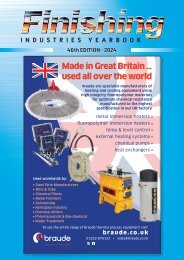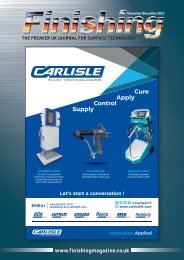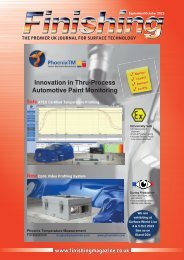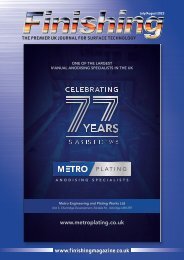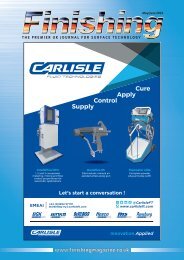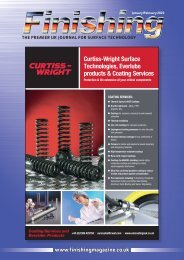You also want an ePaper? Increase the reach of your titles
YUMPU automatically turns print PDFs into web optimized ePapers that Google loves.
40 ABRASIVES<br />
Abrasive action<br />
With new advances in abrasive<br />
technology, machining center<br />
operators are able to complete surface<br />
finishing simultaneously with other machining<br />
operations, to speed cycle times, improve<br />
quality and save on off-line finishing time and<br />
costs. As a result, contract machine shops are<br />
increasingly turning to abrasive finishing tools<br />
that can be easily integrated into CNC<br />
machines carousels or tool holding systems.<br />
However, in doing so, questions inevitably<br />
arise about the use of abrasive materials in<br />
expensive CNC machining centers. The<br />
concern is often a generalized impression that<br />
“abrasives” – like sandpaper – release large<br />
amounts of grit and debris that could clog<br />
coolant lines or damage exposed slides or<br />
bearings.<br />
“These are very expensive, very accurate<br />
machines,” says Janos Garaczi, president of<br />
Delta Machine Company, LLC, a machine<br />
shop specializing in complex, tight tolerance<br />
parts made of titanium, nickel alloys, stainless<br />
steel, aluminum, plastics and other exotic<br />
alloys. “I wouldn’t do anything to jeopardize<br />
the accuracy or lifespan of the equipment.”<br />
Fortunately, a closer examination of abrasive<br />
tools demonstrates that these concerns are<br />
largely unfounded. Although “abrasives” are<br />
often all lumped into the same category, a<br />
distinction must be made between abrasives<br />
used for aggressive material removal and<br />
abrasive finishing tools. <strong>Finishing</strong> tools release<br />
little to no abrasive grit during use, and the<br />
amount generated is comparable to the metal<br />
chips, grinding dust and tool abrasion created<br />
during the machining process itself.<br />
Even if minimal fine solids are produced,<br />
the filtration requirements for abrasive tools<br />
are not much different than for machining.<br />
Any particulate can be easily removed using<br />
inexpensive bag or cartridge filtration systems,<br />
according to Jeff Brooks of Filtra Systems, a<br />
company specializing in industrial filtration<br />
systems including for CNC coolant.<br />
“A disposable media vacuum filter or<br />
pressure filter is the most cost-effective option<br />
for the end user for filtration that will achieve<br />
the high clarity levels required,” explains<br />
Brooks.<br />
“For fine honing work, I would recommend<br />
a 20-micron bag or cartridge filter at<br />
minimum to catch any fine solids and<br />
adequately protect the tool, the sump pump<br />
and keep the coolant ports from clogging,”<br />
says Chris Erato, director of sales at Oberlin<br />
Filter, another leading manufacturer of<br />
separation filtration for CNC coolant systems.<br />
For CNC operators interested in a fully<br />
automated pressure filtration systems, there<br />
are units that eliminate the need to remove<br />
bags or clean magnetic separators that<br />
maximize production uptime.<br />
Case Studies from the CNC Shop<br />
Floor<br />
According to Tim Urano, quality manager at<br />
Wolfram Manufacturing, any additional cost<br />
for filtration related to the use of abrasive<br />
tools is so negligible it is “not really a<br />
consideration because filtration systems are<br />
already required to remove particulate from<br />
<strong>Finishing</strong> - <strong>September</strong>/<strong>October</strong> <strong>2021</strong>






